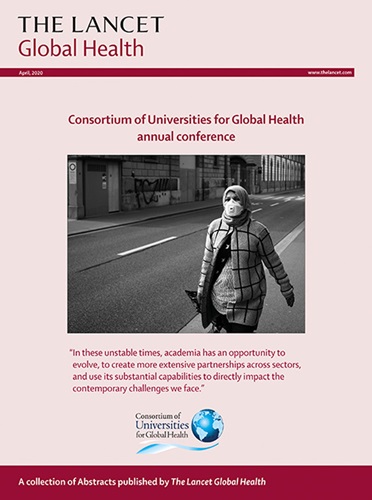撒哈拉以南非洲和南亚地区可能存在严重细菌感染的单一低死亡率风险体征的年幼婴儿的住院与门诊管理:一项开放标签、多中心、两组随机对照试验
IF 19.9
1区 医学
Q1 PUBLIC, ENVIRONMENTAL & OCCUPATIONAL HEALTH
引用次数: 0
摘要
研究表明,具有单一低死亡率风险的可能严重细菌感染(PSBI)体征的幼儿死亡率较低。门诊治疗具有单一低死亡率风险PSBI体征的婴儿(年龄<2个月)可能与住院治疗一样有效和安全。门诊治疗克服了住院治疗的挑战,改善了资源匮乏地区的可及性。我们的目的是评估具有一种低死亡率风险PSBI体征的患者作为门诊治疗与住院治疗的临床结果。方法我们在孟加拉国、埃塞俄比亚、印度、尼日利亚、巴基斯坦和坦桑尼亚的7个地点进行了一项开放标签、多中心、两组随机对照试验。在研究医院就诊的具有三种低死亡率风险PSBI体征之一(即年龄<7天呼吸急促、体温≥38℃或严重胸腔内缩)的婴儿被随机(1:1)分配到门诊治疗组(2天注射庆大霉素加7天口服阿莫西林)或住院治疗组(7天注射氨苄西林加庆大霉素,支持治疗)。主要结局是不良临床结局,这是以下任何一项的综合:死亡、危重疾病、其他严重感染的迹象、随机化后第2、4、8和15天的新PSBI体征或第8天出现症状的持续。我们使用Farrington-Manning分数测试评估优势和非劣效性。该试验在ISRCTN注册中心注册(ISRCTN44033252)。研究结果:在2021年6月24日至2024年4月26日期间,7001名婴儿被纳入研究,并随机分配到门诊治疗组(n=3501)或住院治疗组(n=3500),并且是意向治疗(ITT)人群的一部分。在ITT分析中,3501例门诊患者中有269例(7.7%)出现不良临床结局,3500例住院患者中有272例(7.8%)出现不良临床结局(风险差异为- 0.0009 [95% CI - 0.0134 ~ 0.0116];优势分析p= 1.0000)。门诊组的死亡率(3501例中有9例[0.3%])明显低于住院组(3500例中有23例[0.7%];风险差为- 0.0040[- 0.0072 ~ - 0.008])。在按方案分析中,门诊治疗(3455例中有266例[7.7%])的临床结果不逊于住院治疗(3416例中有269例[7.9%])(风险差异为- 0.0018[- 0.0144至0.0109];非劣效性p= 0.0012)。除死亡外,未发生与治疗相关的严重不良事件。门诊治疗(庆大霉素注射和口服阿莫西林)对单一低死亡率风险PSBI体征的婴儿的治疗不逊于标准住院治疗,门诊治疗组的死亡率显著降低。资助比尔和梅林达·盖茨基金会。本文章由计算机程序翻译,如有差异,请以英文原文为准。
Inpatient versus outpatient management of young infants with a single low-mortality-risk sign of possible serious bacterial infection in sub-Saharan Africa and south Asia: an open-label, multicentre, two-arm, randomised controlled trial.
BACKGROUND
Research has shown low mortality in young infants with a single low-mortality-risk possible serious bacterial infection (PSBI) sign. Outpatient treatment of young infants (age <2 months) with a single low-mortality-risk PSBI sign might be as effective and safe as hospitalisation. Outpatient treatment overcomes the challenges of hospitalisation and improves access in low-resource settings. Our aim was to assess clinical outcomes in patients with one low-mortality-risk PSBI sign treated as outpatients compared with inpatient treatment.
METHODS
We did an open-label, multicentre, two-arm, randomised controlled trial at seven sites across Bangladesh, Ethiopia, India, Nigeria, Pakistan, and Tanzania. Young infants presenting to study hospitals with one of three low-mortality-risk PSBI signs (ie, fast breathing if age <7 days, body temperature ≥38°C, or severe chest indrawing) were randomly assigned (1:1) to the outpatient treatment group (2-day injectable gentamicin plus 7-day oral amoxicillin) or the inpatient treatment group (7-day injectable ampicillin plus gentamicin, with supportive care). The primary outcome was poor clinical outcome, which was a composite of any one of the following: death, critical illness, signs of other serious infections, new PSBI signs on days 2, 4, 8, and 15 or persistence of the presenting sign on day 8 after randomisation. We evaluated superiority and non-inferiority using the Farrington-Manning score test. The trial is registered with the ISRCTN Registry (ISRCTN44033252).
FINDINGS
Between June 24, 2021, and April 26, 2024, 7001 young infants were enrolled and randomly assigned to the outpatient treatment group (n=3501) or the inpatient treatment group (n=3500), and were part of the intention-to-treat (ITT) population. Poor clinical outcomes occurred in 269 (7·7%) of 3501 outpatients and 272 (7·8%) of 3500 inpatients in the ITT analysis (risk difference -0·0009 [95% CI -0·0134 to 0·0116]; p=1·0000 for superiority analysis). Deaths were significantly lower in the outpatient group (nine [0·3%] of 3501) than in the inpatient group (23 [0·7%] of 3500; risk difference -0·0040 [-0·0072 to -0·0008]). In the per-protocol analysis, outpatient treatment (266 [7·7%] of 3455) was non-inferior to inpatient treatment (269 [7·9%] of 3416) for poor clinical outcomes (risk difference -0·0018 [-0·0144 to 0·0109]; p=0·0012 for non-inferiority). Apart from deaths, there were no treatment-related serious adverse events.
INTERPRETATION
Outpatient treatment (gentamicin injection and oral amoxicillin) for infants with a single low-mortality-risk PSBI sign was non-inferior to standard inpatient treatment, with significantly lower mortality in the outpatient treatment group.
FUNDING
Bill and Melinda Gates Foundation.
求助全文
通过发布文献求助,成功后即可免费获取论文全文。
去求助
来源期刊

Lancet Global Health
PUBLIC, ENVIRONMENTAL & OCCUPATIONAL HEALTH-
CiteScore
44.10
自引率
1.20%
发文量
763
审稿时长
10 weeks
期刊介绍:
The Lancet Global Health is an online publication that releases monthly open access (subscription-free) issues.Each issue includes original research, commentary, and correspondence.In addition to this, the publication also provides regular blog posts.
The main focus of The Lancet Global Health is on disadvantaged populations, which can include both entire economic regions and marginalized groups within prosperous nations.The publication prefers to cover topics related to reproductive, maternal, neonatal, child, and adolescent health; infectious diseases (including neglected tropical diseases); non-communicable diseases; mental health; the global health workforce; health systems; surgery; and health policy.
 求助内容:
求助内容: 应助结果提醒方式:
应助结果提醒方式:


